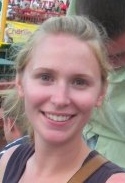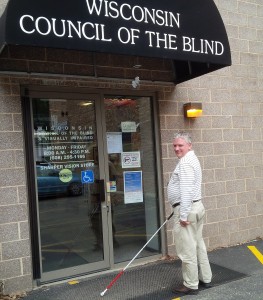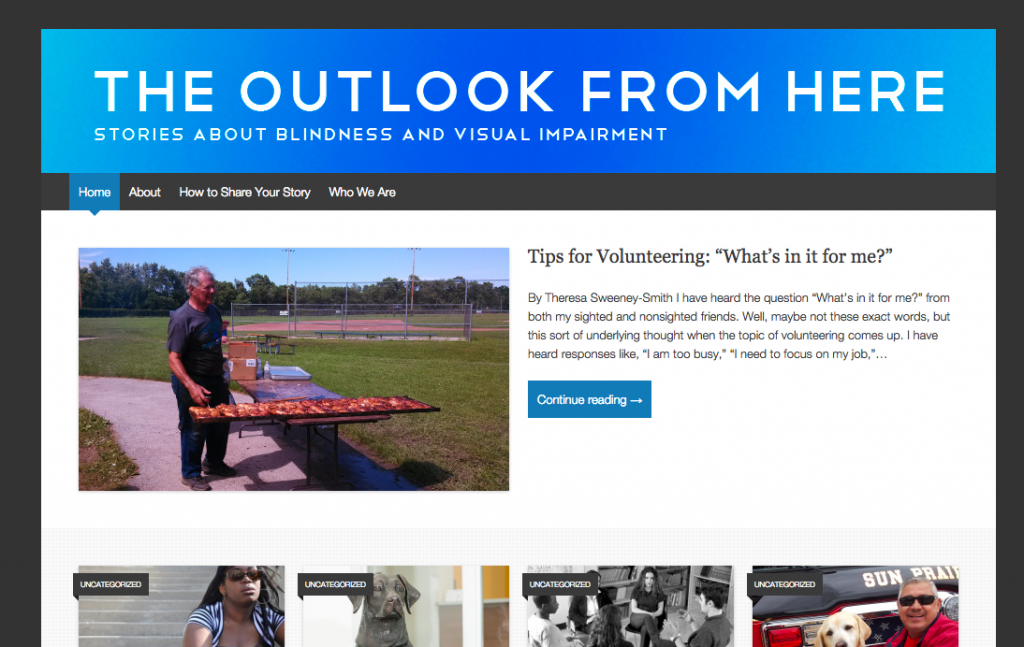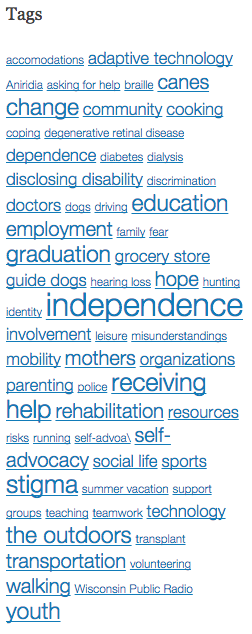By Annika Konrad

Annika Konrad is in her third year as a Writing Center tutor at University of Wisconsin-Madison. She is also a Ph.D. Candidate in Composition and Rhetoric. She has taught undergraduate writing courses and is a TA assistant director of the first-year writing program.

I was always wary of stepping outside the classroom. As someone who moved straight from college to graduate school, I’ve felt most comfortable working with students. I had a lot of questions about what it would mean for me to bring my skills as a writing instructor to communities outside the university: Would people trust me? Would they view me as a know-it-all academic? Would my university experiences actually translate into helping community members with their writing? For a long time, questions like these prevented me from taking the leap. But when I joined a support group at the Wisconsin Council of the Blind and Visually Impaired in Madison, Wisconsin, I quickly realized I had walked into a relatively unheard community.
I was struck by the stories that people told, but I was also struck by the fact that these stories were only being told within the confines of the meeting room. I hadn’t heard these kinds of stories before. Most of the stories I had heard about blind people involved superhuman feats of strength, like biking across the country or scaling a mountain; in contrast, these stories were about everyday experiences like losing a job due to vision loss, instructing strangers on guide dog etiquette, or dealing with marital strain due to vision loss. I appreciated the opportunity to speak freely in a safe space, but I wondered what would happen if these stories circulated outside of the meeting room. What function could these stories serve?
In the rest of this post, then, I’ll reflect on how my teaching and tutoring experiences within the university informed the ways I approached the community-writing project, and in turn, how working with community writers has taught me a great deal about writers in general.
Recruiting Writers
To avoid going it alone, I applied for a Public Humanities Exchange grant from the Center for the Humanities at UW-Madison and I utilized their resources to brainstorm possibilities. Having little experience in community or disability work, I began from what I know best—teaching and tutoring student writers. I imagined that we would draft, share, provide feedback, and revise. I would supply readings and helpful tips and we would follow a schedule much like a syllabus. So in my recruitment announcement, I described the project as a “new and exciting writing group.” I defined the project as “an opportunity for people who are blind or visually impaired from across Wisconsin to connect, share, and explore their creative talents.” An outreach coordinator at the Wisconsin Council of the Blind and Visually Impaired helped me publicize the project in almost ten different newsletters, websites, and email lists.
After all was said and done, I got only one response. Panic set in. I started wondering, “Does anyone out there even want to write?”
So I did some revising. After consulting with the Public Humanities Program Manager, I came to the conclusion that a slight shift in language might elicit more interest. My second recruitment announcement started with the following line: “Everyone has a story to tell.” I explained the purpose of the project is “to create an archive of stories about the life experiences of people who are blind or visually impaired in Wisconsin.” I ended the announcement with, “All kinds of stories from people of all ages, experiences, and levels of interest are welcome.”
After I publicized this version, I got almost thirty emails from interested individuals. Only half of those people
ended up participating in the project, but the difference in the amount of interest between a “writing group” and a “storytelling project” speaks volumes about the words that motivate writers.
Where to Begin?
Once I had managed to get people interested, I had to figure out how to run the group. First, I wanted to see what the group members wanted to do. This is something that I always intend to do with student writers in composition courses and in the Writing Center, but things don’t always happen that way. First I asked the group members to describe what they wanted to do and why they joined the group. Some described that they are published writers, others write newsletters for their church; others write for their job; others have written unpublished memoirs; and others have never written for pleasure or for work at all. Their reasons for joining the writing group were equally as varied.
Feeling motivated yet perplexed by how I would accommodate such a variety of interests, I reverted to the plan I know best. I introduced the idea of drafting. I supplied a copy of Anne Lamott’s “Shitty First Drafts.” I started encouraging writers to give feedback. I supplied a “best practices for feedback” tip sheet. I asked writers to read their writing aloud. I gave short lectures about “showing versus telling” and the importance of communicating a message in a story.
Over time, though, I started to feel like something was amiss. But it wasn’t the same feeling you get when you know your students haven’t done the reading. I sensed that something else was going on.
Renegotiating the Agenda
From a logistical standpoint, I learned that a number of things I was asking the writers to do simply don’t work in the same way for people who are blind or visually impaired. The assistive technology many of the writers were using to view each other’s drafts made it more difficult to give in-the-moment feedback. Using a screen readers or magnifier makes it
harder to be on the phone and give feedback about a piece of writing that they could not listen to or read in the moment. So we naturally shifted from giving feedback over the phone to giving feedback over email. Similarly, I started to realize that asking writers to read their writing aloud was not necessarily the best strategy for a group in which many writers cannot read their writing without a screen reader. So I started to read their writing aloud for them.
But I sensed that there was something else happening, possibly on the level of rhetoric. I noticed that much of the feedback I was giving was not translating into revised drafts. Many times I suggested that writers tell stories about specific moments, rather than speak about experiences in general. But I sensed that this wasn’t happening for specific reasons—many writers seemed to be making a conscious decision to not make their stories overly descriptive or emotional. Instead, many authors have written instructive pieces (see for instance how to be a self-advocate, how to navigate job interviews, and what to do when you learn you have a disability). At one point a writer told me that she knows from her own experience of being blind since birth that when a sighted person encounters a blind person, they need to be told what to do—not made to feel sorry or scared.

It was at this moment that I realized that these writers were teaching me how to write about disability. The recommendations I tend to make to student writers were not working because I was not thinking about how writing about disability might call for different rhetorical choices. Cultural narratives of blindness overemphasize fear, pity, and deficit. And even I, as someone who is visually impaired, did not fully comprehend how these forces might influence the way one might choose to write a story.
So here are some lessons I’ve learned from this experience that I believe can be applied to any teaching or tutoring situation:
- The conventional ways we conceive of helpful approaches to the writing process (I.e. reading aloud, providing oral feedback) might not always be the most accessible means of engaging in the writing process. In our classrooms and in the Writing Center, we should strive to provide as many options for engaging, and sometimes those options may not already be apparent to us.
- My own life experiences do not suffice as the basis for understanding how storytelling, or rhetoric, works. Each individual’s life experiences shape the way they approach communication, and as teachers and tutors we should facilitate exploration of those methods, rather than restrict them.
- And finally, if we truly listen to writers’ own goals, rather than relying on our own plans and priorities, we might learn more about writing and rhetoric than we knew before.
How have your experiences working with community writers informed your pedagogy? How have your university teaching and tutoring experiences informed your community work? What’s similar and what’s different?
Featured image description: This is a photo of a couple of the storytelling project members with myself and my family at the Foundation Fighting Blindness VisionWalk fundraiser in Milwaukee, Wisconsin in April 2014. Two people are wearing Milwaukee Bucks t-shirts and everyone is wearing sunglasses. We all have our arms around each other and behind us are some trees along Milwaukee’s lakefront.
A note about image descriptions: I have included image descriptions in order to make this blog post accessible to people who are blind or visually impaired. If you have any suggestions for how to improve these image descriptions or other ways to make this post more accessible, please feel free to let me know.




I really appreciated reflecting on your process of establishing community centered writing groups. We often take the tools we use within the university space for granted, and this is a great reminder of how we can grow our skills and tool when we move our teaching into new locations and into new communities. Most of all I really enjoyed reading about how your own expectations about narrative shifted throughout this experience — thank you for sharing openly and eloquently about this process and I look forward to continuing to learn from your work with this group!
Wow, this post is really phenomenal. I love the way you point out that disability isn’t just about making a technical change, or about using a particular assistive technology, but that it fundamentally changes things: it changes the relationships people have with each other (particularly as they grow over time), it changes the way they move in shared social space together, and — most poignantly from your writing, I notice the importance of shared negotiation and reciprocal back and forth in shaping that space. I’ve been reading Jay Dolmage’s work recently and one thing he’s written about in a 2009 article titled “Disability, Usability, Universal Design” that appeared in a collection titled _Rhetorically Rethinking Usability_ he talks about a study he did where he followed several teachers who tried to implement universal design in their courses and after the semester ended, he invited students to a focus group to talk about universal design. He says that what he learned was that the students had SO MUCH to say about their classroom experience that they never would have said in an online form or survey, and which certainly wasn’t available before the semester started as teachers were prepping and putting together materials. So the lesson he came away from it was that there needed to be processes where studetnts and teachers were regularly in recursive design conversation with one another. Your piece also really resonates with the work Tiffany Rousculp describes doing in her own community writing center at Salt Lake Community College. I love this and am really looking forward to learning more about how this project grew and took shape relationally!
This is a great post, Annika, and I, too, want to know more about the origins of the project and where you’re headed with it! 🙂 This resonates so much with many of the discussions we’ve been having in my grad seminar this semester (an Intro to Disability Studies course!). I have a couple tutors in there, and I’ll be sure to share this with them since you do such an awesome job connecting conversations about DS, writing center work, and community writing. (Heck, I’ll share the post with all my students!)
As you describe how your process and approach changed, it reminds me that at the core of universal design is flexibility–allowing students to find and articulate what works best for them. This can often be easier said than done in the classroom, but your description of the change of the dynamic with these writers reminds me to remain committed to flexibility in particular (and universal design for learning as whole!).
Oh! I also love your emphasis on dialogue here–asking writers why they joined the group, allowing for a discussion of the best ways to read and respond, etc. It’s so easy to teach with a “top down” approach, but you illustrate how much we can benefit from a bit more collaboration and conversation.
I thought this blog post was wonderful. I think this project involving the communities around our state is a great way to share our experiences with others. I agree wholeheartly, we as blind and or visually impaired people are very unique in iur committed. I’m so glad to be part of the “newbie project writers”. Honestly have to say writing has been difficult. Since my friend told me about this writing project, has been therapeutic for me in the last several years now. It really helps me to think about how far I have come and overcome many obstacles and many more hurdles I will be jumping over to make me happy in life. Thank you again!!!!!!
What a wonderful post! I was struck by the way your article encourages readers to think more critically about how some modes of encouraging peers and students to include specific types of descriptive details in their writing may actually work against writers’ self-conscious resistance to limiting cultural narratives. I will definitely be thinking about ways to hold more thoughtful conversations about writers’ goals in my own teaching and Writing Center work in the future. Thank you!
Very illuminating blog post! I especially love your example of how our own perceptions and experiences can shape our expectations of teaching and engaging in new communities–sometimes in limiting ways. The lessons you’ve come to learn through your participation within this community are not only interesting to consider in this context (as I also loved reading the stories told on your site) but can apply to how we approach writing, teaching, and learning in any new context. Perhaps most importantly, I appreciated your reflection on your uncertainties surrounding this new venture (and how you might be perceived as an academic) and how you were able to engage as a co-learner rather than an expert outsider. It makes me reflect on my own practices and beliefs and the ways they may be inviting or excluding, limiting or opening opportunities for the writers I engage with…
I’ve enjoyed reading The Outlook from Here for the last year, Annika, and the background you explain here helps reveal the kinds of drafting and revision that go into creating a platform for writers. What I’d love to know more about is the transition from the private writing group to the public space of blogging. How have you and your fellow writers talked about your relationship to your audience, and to the audience’s expectations about the work you do? How have your writers reacted to being read, commented on, or tweeted about? So many community writers focus on development rather than publication; why did you decide to go through the hard work of building this platform for public storytelling?
Annika! What amazing work you’re doing that crosses both university and community life! I appreciate your discussion of the writer’s agenda and how that might (and probably often does) differ from what we as instructors think should be the agenda. I was surprised to hear that the writers in this group were less concerned with emotional recounting and more concerned wth instructional methods or instructional tips. It causes me to reconsider how I’m buying into myths or how I’m failing to truly listen to the students in front of me. I work with community writers in Madison as well, and I hear the material concerns from real writers living and writing in the community. Your post encourages me to rethink how experience shapes communication and how as teachers we need to be open to how these experiences influence out writing in profound ways. Beautiful work!
Mike, that is funny that you ask about audience because I had a paragraph about audience in an earlier draft of this blog post! We talked about audience pretty early on when we were deciding what we wanted to do. It was pretty clear from the beginning that people wanted to do something public because everyone strongly agreed that storytelling is a powerful tool for influencing people’s ideas about disability, and we all felt that there just aren’t enough everyday stories out there about disability. Early on the writers also decided that they wanted to reach both sighted and non-sighted readers, and we imagined that many people who land on our site might be new to the idea of blindness or visual impairment (since they might find us through The Wisconsin Council of the Blind and Visually Impaired). So I think on the one hand, we decided early on that we want to affect change by making our stories public, but we also wanted to use those stories to teach and inform. I do think, though, that each person in the group feels slightly differently about all these things, and I think those differences are reflected in their rhetorical choices and writing styles. This is the sort of nuanced understanding I hope to gain by interviewing them!
I really enjoyed reading this post, Annika. I especially appreciate the window you’re providing into the relational, evolving nature of this writing group. The “feeling” that you describe throughout, as a facilitator, that something wasn’t quite right is really interesting to me — seeing how participants pushed on the structure of the group and how you responded. That kind of attunement to writers’ preferences and needs is a great example for the ways we design curriculum, classroom or writing group spaces, and just the ways we respond to students/writers — and, as you say, an important lesson from disability. The strong identity and preferences of these writers is also really interesting — preferring storytelling to “writing,” knowing the kinds of genres they want to compose in and the purposes to write for (informational over emotional, etc.). Looking forward to hearing more about this group!
Annika, I love so much about this post, but especially how you structure it around your own learning process. That’s not necessarily an easy thing to do in our line of work, but it’s so effective as an way of inviting readers into your experience. I was wondering about how you’re feeling about translating your work with the group into the kind of academic context you might have for an article or your research? Does it feel like the sort of thing that you already know how to talk about with multiple audiences or do you think it is going to take a kind of mental shift to frame your experience as a academic argument?
You pointed out that participants could not read what they wrote. However, this is because education systems built by sighted people act as though blind people don’t need to know how to read. Braille reader’s can be just as efficient, if not more so, then print readers, but because people view print as superior somehow, many blind people end up not knowing how to read. They say that they can do everything using a screen reader, but as you saw, this is not the case and Braille is actually very important. I do believe that even sighted writers need to have already read the story before giving complete feedback, but if you did not want to listen to a screen reader while talking on the phone, you could read in braille if you were able to and had a braille display. Also, I don’t think that leaving emotion out of a story is helpful. I do agree that ignorance is one of the biggest challenges to being blind, but people will never know how harmful they are unless they actually know about the emotions of the people they hurt. If you are qualified, people should know the emotions you feel when you are denied a job simply because you are blind.